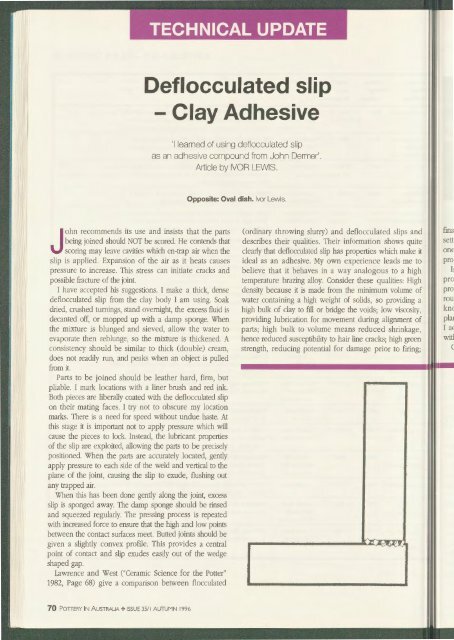Pottery In Australia Vol 35 No 1 Autumn 1996
You also want an ePaper? Increase the reach of your titles
YUMPU automatically turns print PDFs into web optimized ePapers that Google loves.
Deflocculated slip<br />
- Clay Adhesive<br />
'I learned of using deflocculated slip<br />
as an adhesive compound from John Dermer'.<br />
Article by IVOR LEWIS.<br />
Opposite: Oval dish. Ivor Lewis.<br />
J<br />
ohn recommends its use and insists that the parts<br />
being joined should NOT be scored. He contends that<br />
scoring may leave cavities which en-trap air when the<br />
slip is applied. Expansion of the air as it heats causes<br />
pressure to increase. This stress can initiate cracks and<br />
possible fracture of the joint.<br />
I have accepted his suggestions. I make a thick, dense<br />
deflocculated slip from the clay body I am using. Soak<br />
dried, crushed turnings, stand overnight, the excess fluid is<br />
decanted off, or mopped up with a damp sponge. When<br />
the mixture is blunged and sieved, allow the water to<br />
evaporate then reblunge, so the mixture is thickened. A<br />
consistency should be similar to thick (double) cream,<br />
does not readily run, and peaks when an object is pulled<br />
from it.<br />
Parts to be joined should be leather hard, firm, but<br />
pliable. I mark locations with a liner brush and red ink.<br />
Both pieces are liberally coated with the deflocculated slip<br />
on their mating faces. I try not to obscure my location<br />
marks. There is a need for speed without undue haste. At<br />
this stage it is important not to apply pressure which will<br />
cause the pieces to lock. <strong>In</strong>stead, the lubricant properties<br />
of the slip are exploited, allowing the parts to be precisely<br />
positioned. When the parts are accurately located, gently<br />
apply pressure to each side of the weld and vertical to the<br />
plane of the joint, causing the slip to exude, flushing out<br />
any trapped air.<br />
When this has been done gently along the joint, excess<br />
slip is sponged away. The damp sponge should be rinsed<br />
and squeezed regularly. The pressing process is repeated<br />
with increased force to ensure that the high and low points<br />
between the contact surfaces meet. Butted joints should be<br />
given a slightly convex profile. This provides a central<br />
point of contact and slip exudes easily out of the wedge<br />
shaped gap.<br />
Lawrence and West ("Ceramic Science for the Potter"<br />
1982, Page 68) give a comparison between flocculated<br />
(ordinary throwing slurry) and deflocculated slips and<br />
describes their qualities. Their information shows quite<br />
clearly that deflocculated slip has properties which make it<br />
ideal as an adhesive. My own experience leads me to<br />
believe that it behaves in a way analogous to a high<br />
temperature brazing alloy. Consider these qualities: High<br />
density because it is made from the minimum volume of<br />
water containing a high weight of solids, so providing a<br />
high bulk of clay to fill or bridge the voids; low viscosity,<br />
providing lubrication for movement during alignment of<br />
parts; high bulk to volume means reduced shrinkage,<br />
hence reduced susceptibility to hair line cracks; high green<br />
strength, reducing potential for damage prior to firing;<br />
fina<br />
sett<br />
onE<br />
pro<br />
l1<br />
pro<br />
pro<br />
rou<br />
knc<br />
plat<br />
I ac<br />
witl<br />
C<br />
70 POTTERY IN AUSTRALIA+ ISSUE <strong>35</strong>/ I AUTUMN <strong>1996</strong>

















